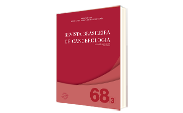Segregação Residencial Racial e Mortalidade por Câncer do Colo do Útero nas Regiões de Saúde do Brasil
DOI:
https://doi.org/10.32635/2176-9745.RBC.2022v68n3.2458Palavras-chave:
segregação social, neoplasias do colo do útero, análise espacial, disparidades nos níveis de saúdeResumo
Introdução: O câncer do colo do útero (CCU) é um dos mais frequentes em mulheres e tem sido relacionado a baixos níveis de desenvolvimento. Objetivo: Investigar a associação entre a taxa de mortalidade padronizada por CCU e a segregação residencial racial. Método: Estudo ecológico que teve como unidade de análise as 438 Regiões de Saúde do Brasil em 2010. O desfecho foi a taxa de mortalidade por CCU em mulheres, padronizada por idade, por 100 mil mulheres. A exposição de interesse foi o Índice de Interação Racial (IIR), uma medida de segregação residencial da dimensão uniformidade, estimada a partir de dados do Censo Demográfico 2010 agregados por setores censitários. O Índice de Desenvolvimento Humano (IDH) foi covariável de controle. A associação entre as variáveis foi analisada por modelo de regressão linear. Resultados: A taxa de mortalidade por CCU teve os maiores valores nas Regiões de Saúde do Norte e do Centro-Oeste, e os menores no Sul e no Sudeste, padrão diferente do IDH e do IIR, com valores menores no Norte e no Nordeste e maiores no Sul e no Sudeste. O IIR teve associação negativa com a taxa de mortalidade; no modelo ajustado pelo IDH, cada aumento de 0,1 no IIR esteve associado à diminuição de 0,6 óbitos por 100 mil mulheres. Conclusão: A segregação residencial racial está associada à mortalidade por CCU. Os indicadores de segregação residencial deveriam ser considerados para inclusão em futuros estudos epidemiológicos como importantes determinantes contextuais do processo saúde-doença.
Downloads
Referências
Sung H, Ferlay J, Siegel RL, et al. Global cancer statistics 2020: GLOBOCAN estimates of incidence and mortality worldwide for 36 cancers in 185 countries. CA Cancer J Clin. 2021;71(3):209-49. doi: https://doi.org/10.3322/caac.21660 DOI: https://doi.org/10.3322/caac.21660
Reis NVS, Andrade BB, Guerra MR, et al. The global burden of disease study estimates of Brazil’s cervical cancer burden. Ann Glob Health. 2020;86(1):56. doi: https://doi.org/10.5334/aogh.2756 DOI: https://doi.org/10.5334/aogh.2756
Silva GA, Jardim BC, Ferreira VM, et al. Mortalidade por câncer nas capitais e no interior do Brasil: uma análise de quatro décadas. Rev Saude Publica. 2020;54:126. doi: https://doi.org/10.11606/s1518-8787.2020054002255 DOI: https://doi.org/10.11606/s1518-8787.2020054002255
Oliveira NPD, Siqueira CAS, Lima KYN, et al. Association of cervical and breast cancer mortality with socioeconomic indicators and availability of health services. Cancer Epidemiol. 2020;64:101660. doi: https://doi.org/10.1016/j.canep.2019.101660 DOI: https://doi.org/10.1016/j.canep.2019.101660
Landrine H, Corral I, Lee JGL, et al. Residential segregation and racial cancer disparities: a systematic review. J Racial Ethn Health Disparities. 2017;4(6):1195-1205. doi: https://doi.org/10.1007/s40615-016-0326-9 DOI: https://doi.org/10.1007/s40615-016-0326-9
Massey DS, Denton NA. The dimensions of residential segregation. Soc Forces [Internet]. 1988 [cited 2022 Aug 12];67(2):281-315. Available from: https://academic.oup.com/sf/article-pdf/67/2/281/6514769/67-2-281.pdf DOI: https://doi.org/10.2307/2579183
Presidência da República (BR). Lei nº 7.508, de 28 de junho de 2011. Regulamenta a Lei no 8.080, de 19 de setembro de 1990, para dispor sobre a organização do Sistema Único de Saúde – SUS, o planejamento da saúde, a assistência à saúde e a articulação interfederativa, e dá outras providências. Diário Oficial da União, Brasília, DF. 2011 jun 28. [acesso 2022 ago 12]; Seção 1:1. Disponível em: https://www2.camara.leg.br/legin/fed/decret/2011/decreto-7508-28-junho-2011-610868-norma-pe.html
PROADESS: Projeto de Avaliação do Desempenho do Sistema de Saúde [Internet]. Rio de Janeiro: ICICT; c2011 [acesso 2022 ago 12]. Disponível em: https://www.proadess.icict.fiocruz.br/index.php
Instituto Brasileiro de Geografia e Estatística [Internet]. Rio de Janeiro: IBGE; [data desconhecida]. Estatísticas: downloads: censo; 2010 [acesso 2022 ago 12]. Disponível em: https://www.ibge.gov.br/estatisticas/downloads-estatisticas.html
Sparks CS. Calculating indices of residential segregation. San Antonio, TX: UTSA Department of Demography; 2019 Mar 6 [cited 2021 Mayo 19]. Available from: https://rpubs.com/corey_sparks/473785
R: The R Project for Statistical Computing [Internet]. Version 3.6.1. [place unknown]: The R foundation. 2019 July 5 - [cited 2022 Agu 12]. Available from: https://www.r-project.org
Ministério da Saúde (BR), Conselho Nacional de Saúde. Resolução nº 510, de 7 de abril de 2016. Dispõe sobre as normas aplicáveis a pesquisas em Ciências Humanas e Sociais cujos procedimentos metodológicos envolvam a utilização de dados diretamente obtidos com os participantes ou de informações identificáveis ou que possam acarretar riscos maiores do que os existentes na vida cotidiana, na forma definida nesta Resolução. Diário Oficial da União, Brasília, DF. 2016 maio 24 [acesso 2022 ago 12]; Seção 1:44. Disponível em: https://bvsms.saude.gov.br/bvs/saudelegis/cns/2016/res0510_07_04_2016.html
Westrick AC, Bailey ZD, Schlumbrecht M, et al. Residential segregation and overall survival of women with epithelial ovarian cancer. Cancer. 2020;126(16):3698-707. doi: https://doi.org/10.1002/cncr.32989 DOI: https://doi.org/10.1002/cncr.32989
Haas JS, Earle CC, Orav JE, et al. Racial segregation and disparities in cancer stage for seniors. J Gen Intern Med. 2008;23(5):699-705. doi: https://doi.org/10.1007/s11606-008-0545-9 DOI: https://doi.org/10.1007/s11606-008-0545-9
Hayanga AJ, Zeliadt SB, Backhus LM. Residential segregation and lung cancer mortality in the United States. JAMA Surg. 2013;48(1):37-42. doi: https://doi.org/10.1001/jamasurgery.2013.408 DOI: https://doi.org/10.1001/jamasurgery.2013.408
Johnson AM, Johnson A, Hines RB, et al. The effects of residential segregation and neighborhood characteristics on surgery and survival in patients with early-stage non-small cell lung cancer. Cancer Epidemiol Biomarkers Prev. 2016;25(5):750-8. doi: https://doi.org/10.1158/1055-9965.EPI-15-1126 DOI: https://doi.org/10.1158/1055-9965.EPI-15-1126
Russell E, Kramer MR, Copper HLF, et al. Residential racial composition, spatial access to care, and breast cancer mortality among women in Georgia. J Urban Health. 2011;88(6):1117-29. doi: https://doi.org/10.1007/s11524-011-9612-3 DOI: https://doi.org/10.1007/s11524-011-9612-3
Pruitt SL, Lee SJC, Tiro JA, et al. Residential racial segregation and mortality among black, white, and Hispanic urban breast cancer patients in Texas, 1995 to 2009. Cancer. 2015;121(11):1845-55. doi: https://doi.org/10.1002/cncr.29282 DOI: https://doi.org/10.1002/cncr.29282
Hao Y, Landrine H, Smith T, et al. Residential segregation and disparities in health-related quality of life among black and white cancer survivors. Health Psychol. 2011;30(2):137-44. doi: https://doi.org/10.1037/a0022096 DOI: https://doi.org/10.1037/a0022096
Downloads
Publicado
Como Citar
Edição
Seção
Licença
Os direitos morais e intelectuais dos artigos pertencem aos respectivos autores, que concedem à RBC o direito de publicação.

Este trabalho está licenciado sob uma licença Creative Commons Attribution 4.0 International License.









